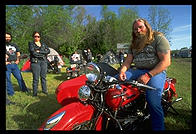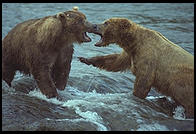
Nikon Digital SLR System
a photo.net guide by Philip Greenspun

The Nikon system of digital single-lens reflex (SLR) bodies and lenses is a popular choice among serious photographers worldwide. This page makes it easy to shop for Nikon digital bodies and Nikkor lenses. Every component manufactured by Nikon is covered, plus a few exceptionally good third-party components. If you are new to photography, you might want to start with my article "Building a Digital SLR System".
This article goes through every section of the Nikon system and concludes with some starter system recommendations.
Nikon Camera Bodies
Most Nikon digital SLR bodies incorporate a "small sensor" or "APS-C" sized sensor. This is smaller than the standard 35mm film frame and effectively multiplies the magnification of any lens attached to the body. A small sensor is good for telephoto work, such as wildlife photography, where a 300mm lens that is too short for bird photography on a film camera becomes a 450mm (effective) lens. In November 2007, Nikon added the D3, their first full-frame sensor DSLR professional camera to their arsenal of DSLR bodies. The full-frame sensor bodies are good for wide angle photography, low light photography, and optimum image quality.
Nikon D40, 18-55mm kit, $450 (review), 6 MP and good enough for most family photography; best user interface of any digital SLR, with example photos displayed on the rear LCD to show appropriate situations for different settings. Note that the D40 requires SD memory cards rather than the standard CF cards used by other Nikon bodies- Nikon D40x, $590 (review), same idea, but 10 MP; if you care about image quality, pair with Sigma 30mm f/1.4 EX DC for Nikon, $439
- Nikon D60, $561 (review), 10 MP, Nikon's latest addition to the line of small-body DSLRs, an upgrade to the D40/D40x
- Nikon D80 (review), 10 MP, Nikon's answer to the Canon Digital Rebel XTi; the kit zooms are reasonably good, but too slow for indoor usage
- Nikon D90, $975 (review), 12 MP, Nikon's latest prosumer model, includes GPS and a movie mode capable of capturing 1280x720 pixel images at 24 fps HD with sound.
- Nikon D200 (review), 10 MP, the camera for most advanced amateurs
- Nikon D300, $1697 (review), 12 MP, released at the same time as the D3, a fast camera with 51 AF points
- Nikon D2HS, $5987 (review), only 4 Megapixels but tremendously fast; intended for sports photojournalists
- Nikon D2Xs (review), 12 MP, before the full-frame sensor cameras came along, this was Nikon's top-of-the-line camera
- Nikon D700, $2399 (review), 12 MP, D3 image quality at about half the price
- Nikon D3, $4350 (review), 12 MP, Nikon's first full frame sensor DSLR
- Nikon D3X, $7596 (review), 24.5 MP, D3 image quality with about double the resolution
For nostalgia buffs and collectors, Nikon still makes film bodies:
in-production
- Nikon F6, $2399 (review), autofocus, probably the best 35mm film SLR that will ever be made
- Nikon FM10 with 35-70 lens, $310, manual focus, designed for students in intro photography classes
discontinued
- Nikon F5, $1100
- Nikon F100, $550 (review), much lighter and smaller than the F-series and almost as durable; this was the standard "second body" that professionals carried in the film days
- Nikon N80, $217 (review), mostly plastic body, reasonably good autofocus and autoexposure systems; rememeber that it is the lens that determines image quality (might actually be cheaper as a kit with a crummy lens: Nikon N80 with 28-80 lens, $300 (review))
- Three incredibly cheap, all plastic, not very good bodies: Nikon N55, $150;
- Nikon FM3A, $800 (review), hard to find; Nikon came out with this all-metal manual focus body in 2001. It is a beautifully balanced camera and, with a 50/1.4 lens, will take much better pictures than what 99 percent of digital camera owners capture with their cheap kit zoom lenses.
Nomenclature
F-number: lower is better.
VR is "vibration reduction", a technology lifted from camcorder image stabilizers. The lens electronically compensates for unsteady hands. VR is especially important at long focal lengths, e.g., 200mm and above, because the lens magnifies camera shake at the same time it is magnifying the subject. A VR lens will allow you to use slower shutter speeds without introducing camera shake. The alternative to a VR lens would be mounting the camera on a tripod or using a high ISO setting, which reduces image quality but allows the use of higher shutter speeds.
"ED" is "extra-low dispersion" glass, a more expensive and higher quality glass that reduces chromatic aberration, in which light of different colors takes different paths through the lens, which would result in a dot of white light being fuzzed up by the time it reaches the film or sensor.
"IF" is internal focus, meaning that the lens does not change physical length as you focus on subjects that are closer or farther away.
"DX" are Nikon's lenses that only work on its small-sensor digital SLR bodies, i.e., they don't cast a large enough image circle to be used on a film camera.
"FX" refers to the full frame sensor
"G" lenses are Nikon's newest lenses. They don't have an aperture ring, which is a shame because it means that you are forced to adjust the aperture with a command wheel on the camera. The G lenses don't work on older bodies.
AF-S is "silentwave motor". Old-style Nikon autofocus lenses did not have motors in the lens, but relied on a screwdriver blade in the camera body to turn the focus ring. An AF-S lens has a built-in ultrasonic motor, a technology copied from the Canon EOS system. When using an AF-S lens, the photographer can push the shutter release (or a button on the rear of the camera, if a custom function is set) and let the autofocus system do its best, then touch up the focus manually by twisting the lens ring. The AF-S lenses also focus faster and more quietly.
